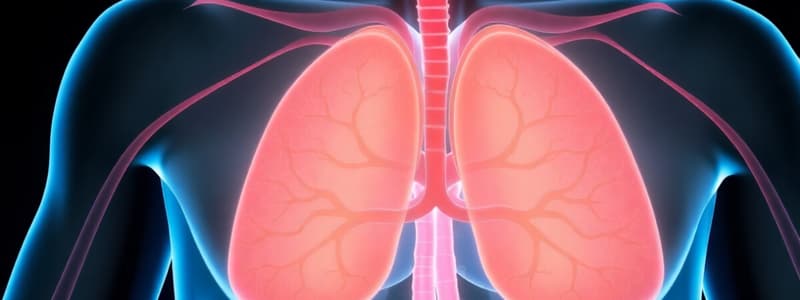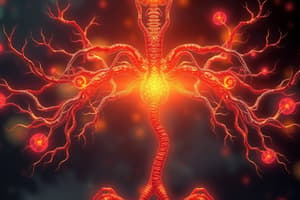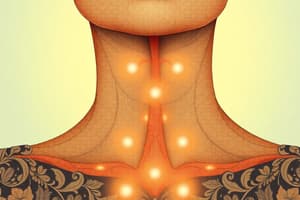Podcast
Questions and Answers
Which endocrine disorder is considered the most common?
Which endocrine disorder is considered the most common?
- Pheochromocytoma
- Diabetes mellitus (correct)
- Cushing syndrome
- Hypothyroidism
Which glands are primarily involved in endocrine regulation?
Which glands are primarily involved in endocrine regulation?
- Pancreas and parathyroid glands
- Pituitary and pineal glands
- All endocrine glands (correct)
- Thyroid and adrenal glands
What is a major cause of thyroid dysfunction in certain populations?
What is a major cause of thyroid dysfunction in certain populations?
- Exposure to toxins
- Autoimmune disorder
- Iodine deficiency (correct)
- Genetic predisposition
What percentage of women aged 20-50 years in the UK is affected by thyroid dysfunction?
What percentage of women aged 20-50 years in the UK is affected by thyroid dysfunction?
What is the primary role of hormones in the endocrine system?
What is the primary role of hormones in the endocrine system?
Which system is directly involved in regulating most endocrine glands?
Which system is directly involved in regulating most endocrine glands?
What is one reason why diabetic patients may experience hunger despite normal blood sugar levels?
What is one reason why diabetic patients may experience hunger despite normal blood sugar levels?
Which gland is primarily associated with the secretion of glucagon?
Which gland is primarily associated with the secretion of glucagon?
What primarily controls hormone secretion from the anterior pituitary?
What primarily controls hormone secretion from the anterior pituitary?
How are posterior pituitary hormones transported to their release site?
How are posterior pituitary hormones transported to their release site?
What is the primary mechanism through which hormone release is regulated?
What is the primary mechanism through which hormone release is regulated?
In the context of axes in endocrine systems, what role do binding globulins play?
In the context of axes in endocrine systems, what role do binding globulins play?
Which of the following is NOT considered a type of hormone?
Which of the following is NOT considered a type of hormone?
What is the primary function of hormone receptors located on the cell surface?
What is the primary function of hormone receptors located on the cell surface?
What endocrine disorder is indicated by symptoms of sodium retention and excessive potassium excretion?
What endocrine disorder is indicated by symptoms of sodium retention and excessive potassium excretion?
Which component of the hormone pathway affects cell function through changes in gene expression?
Which component of the hormone pathway affects cell function through changes in gene expression?
What type of signaling is utilized when hormones are secreted into the bloodstream?
What type of signaling is utilized when hormones are secreted into the bloodstream?
What physiological change is primarily caused by amine hormones like norepinephrine?
What physiological change is primarily caused by amine hormones like norepinephrine?
What does thyrotoxicosis specifically refer to?
What does thyrotoxicosis specifically refer to?
Which condition is associated with hyperthyroidism?
Which condition is associated with hyperthyroidism?
What distinguishes thyroiditis post-pharyngitis from other forms of hyperthyroidism?
What distinguishes thyroiditis post-pharyngitis from other forms of hyperthyroidism?
What symptoms might be exhibited in cases of thyrotoxicosis?
What symptoms might be exhibited in cases of thyrotoxicosis?
What is a characteristic of insulinomas in relation to imaging techniques?
What is a characteristic of insulinomas in relation to imaging techniques?
What is a common consequence of untreated insulinomas?
What is a common consequence of untreated insulinomas?
In managing thyrotoxicosis and hyperthyroidism, what aspect is important to consider?
In managing thyrotoxicosis and hyperthyroidism, what aspect is important to consider?
Which statement is true regarding hyperthyroidism?
Which statement is true regarding hyperthyroidism?
Which of the following is a symptom not typically associated with hyperthyroidism?
Which of the following is a symptom not typically associated with hyperthyroidism?
What physiological response would you expect in a patient experiencing tachycardia due to thyrotoxicosis?
What physiological response would you expect in a patient experiencing tachycardia due to thyrotoxicosis?
Which hormones bind to specific intracellular receptors?
Which hormones bind to specific intracellular receptors?
What is the primary function of the hormone/receptor complex in gene expression regulation?
What is the primary function of the hormone/receptor complex in gene expression regulation?
What is an example of primary endocrine disease?
What is an example of primary endocrine disease?
How do some hormones act in a paracrine manner?
How do some hormones act in a paracrine manner?
What is the role of the enzyme aromatase in hormone synthesis?
What is the role of the enzyme aromatase in hormone synthesis?
Secondary endocrine disease results from what kind of stimulation?
Secondary endocrine disease results from what kind of stimulation?
What might lead to multiple endocrine gland disorders in patients?
What might lead to multiple endocrine gland disorders in patients?
How are endocrine glands typically affected by pathological processes?
How are endocrine glands typically affected by pathological processes?
What distinguishes primary from secondary hypothyroidism?
What distinguishes primary from secondary hypothyroidism?
Which statement is true regarding the classical model of endocrine function?
Which statement is true regarding the classical model of endocrine function?
What is a common cause of hormone excess syndromes?
What is a common cause of hormone excess syndromes?
Which condition is associated with impaired feedback inhibition of ACTH secretion?
Which condition is associated with impaired feedback inhibition of ACTH secretion?
What often leads to hormone deficiency states?
What often leads to hormone deficiency states?
What type of tumors often retain the capacity to produce hormones?
What type of tumors often retain the capacity to produce hormones?
Hashimoto’s thyroiditis is an example of which type of endocrine disorder?
Hashimoto’s thyroiditis is an example of which type of endocrine disorder?
What is the primary mechanism by which hormone deficiencies occur?
What is the primary mechanism by which hormone deficiencies occur?
What can cause subtle defects in feedback regulation of endocrine hormones?
What can cause subtle defects in feedback regulation of endocrine hormones?
Flashcards
What are hormones?
What are hormones?
Chemical messengers produced by endocrine glands that regulate various bodily functions.
What is Endocrinology?
What is Endocrinology?
The study of hormones, their production, and their effects on the body.
What are Endocrine Diseases?
What are Endocrine Diseases?
A group of diseases affecting the endocrine glands, leading to imbalances in hormone production.
What is Thyroid Dysfunction?
What is Thyroid Dysfunction?
Signup and view all the flashcards
What is Diabetes Mellitus?
What is Diabetes Mellitus?
Signup and view all the flashcards
What is Primary Hyperparathyroidism?
What is Primary Hyperparathyroidism?
Signup and view all the flashcards
What is Pheochromocytoma?
What is Pheochromocytoma?
Signup and view all the flashcards
What is Cushing Syndrome?
What is Cushing Syndrome?
Signup and view all the flashcards
What is thyrotoxicosis?
What is thyrotoxicosis?
Signup and view all the flashcards
What is hyperthyroidism?
What is hyperthyroidism?
Signup and view all the flashcards
What is Grave's disease?
What is Grave's disease?
Signup and view all the flashcards
What is thyroiditis?
What is thyroiditis?
Signup and view all the flashcards
What is an insulinoma?
What is an insulinoma?
Signup and view all the flashcards
How are insulinomas diagnosed?
How are insulinomas diagnosed?
Signup and view all the flashcards
What are some common symptoms of thyrotoxicosis and thyroiditis?
What are some common symptoms of thyrotoxicosis and thyroiditis?
Signup and view all the flashcards
How are the causes and management of thyrotoxicosis and thyroiditis different?
How are the causes and management of thyrotoxicosis and thyroiditis different?
Signup and view all the flashcards
Intracellular Hormone Receptors
Intracellular Hormone Receptors
Signup and view all the flashcards
Hormone/Receptor Complex
Hormone/Receptor Complex
Signup and view all the flashcards
Ligand-Activated Transcription Factor
Ligand-Activated Transcription Factor
Signup and view all the flashcards
Classical Endocrine Function
Classical Endocrine Function
Signup and view all the flashcards
Peripheral Hormone Metabolism
Peripheral Hormone Metabolism
Signup and view all the flashcards
Paracrine Action
Paracrine Action
Signup and view all the flashcards
Autocrine Action
Autocrine Action
Signup and view all the flashcards
Primary Endocrine Pathology
Primary Endocrine Pathology
Signup and view all the flashcards
Secondary Endocrine Pathology
Secondary Endocrine Pathology
Signup and view all the flashcards
Multiple Endocrine Disorders
Multiple Endocrine Disorders
Signup and view all the flashcards
Anterior Pituitary Hormone Control
Anterior Pituitary Hormone Control
Signup and view all the flashcards
Posterior Pituitary Hormone Release
Posterior Pituitary Hormone Release
Signup and view all the flashcards
Regulation of Hormone Release
Regulation of Hormone Release
Signup and view all the flashcards
Endocrine Axis
Endocrine Axis
Signup and view all the flashcards
Resistant Hypertension
Resistant Hypertension
Signup and view all the flashcards
What is Conn's Syndrome?
What is Conn's Syndrome?
Signup and view all the flashcards
Hormone Action
Hormone Action
Signup and view all the flashcards
Types of Hormones
Types of Hormones
Signup and view all the flashcards
Hormone Receptors
Hormone Receptors
Signup and view all the flashcards
Binding Globulins
Binding Globulins
Signup and view all the flashcards
What is Cushing's disease?
What is Cushing's disease?
Signup and view all the flashcards
What are the three key glands involved in hormone disorders?
What are the three key glands involved in hormone disorders?
Signup and view all the flashcards
What are the main causes of hormone excess syndromes?
What are the main causes of hormone excess syndromes?
Signup and view all the flashcards
Why do benign endocrine tumors often continue to produce hormones?
Why do benign endocrine tumors often continue to produce hormones?
Signup and view all the flashcards
What are the main causes of hormone deficiency?
What are the main causes of hormone deficiency?
Signup and view all the flashcards
What are the genetic causes of hormone deficiencies?
What are the genetic causes of hormone deficiencies?
Signup and view all the flashcards
What are two examples of common autoimmune endocrine diseases?
What are two examples of common autoimmune endocrine diseases?
Signup and view all the flashcards
Study Notes
Introduction to Endocrinology
- Covid can cause an increase in the number of diabetes mellitus cases. The mechanism involves an inflammatory process that disrupts insulin binding to its receptors, causing the disease. This occurs after the inflammation affects the post-receptor interaction.
- Endocrine pathologies exist at different levels, such as hypoparathyroidism, pseudohypoparathyroidism, or pseudopsuedohypoparathyroidism. Hypoparathyroidism is caused by organ damage; pseudohypoparathyroidism presents with normal parathyroid hormone levels but issues with receptor binding; and pseudopsuedohypoparathyroidism has normal levels and binding but presents with issues at the post-receptor interaction level.
Endocrine Diseases
- Most endocrine diseases are multi-systemic and involve several organs. The focus of the clinical examination should determine which gland or hormone is faulty.
- Diabetes mellitus and thyroid disease are the two most common endocrine disorders.
- Thyroid dysfunction concerns a significant portion of the population, with iodine deficiency often implicated (e.g., in the Himalayas) or 4% of women aged 20-50 in the UK.
- Weight loss, good appetite, and diabetes, along with hyperthyroidism and malabsorption, can occur together.
- In normal individuals, blood sugar regulation occurs and follows typical patterns. Post-meal sugar levels rise, then subsequently fall to a baseline of 70mg/dL, triggering hunger. In diabetes mellitus patients, this normal function is impaired, resulting in delayed or absent glucose regulation.
Clinical Examination in Endocrine Disease
- Clinical symptoms of endocrine diseases often include issues with blood pressure, pulse, skin, hair, and other organ systems.
- Clinical presentation often involves blood pressure, pulse, skin, hair, eyes, neck, face features, voice, mental state, mood, and other features.
- Physical examination may include checking extremities, hands, palms, body fat, bones, and genitalia, highlighting possible abnormal features. Observation and assessment are essential for an accurate diagnosis.
Functional Anatomy and Physiology
- Some endocrine glands respond to metabolic signals directly while others are controlled by pituitary hormones.
- Anterior pituitary hormone secretion is regulated by hypothalamic factors.
- Posterior pituitary hormones are produced in the hypothalamus and transported down nerve axons before release.
- The integrated feedback control of endocrine systems involves stimuli and feedback from the target glands.
Clinical Presentation - Endocrine Pathology
- Pathology arising within a gland is considered "primary." (e.g., Hashimoto's thyroiditis)
- Stimulated (or abnormal) gland activity, is called "secondary." (e.g., pituitary-related hypothyroidism)
- Diseases can impact multiple endocrine glands.
- Conditions can be genetic or a consequence of treatments (e.g., chemotherapy).
- Thyroid conditions like thyrotoxicosis demonstrate increased thyroid hormone levels and symptoms like sweating, tachycardia, and tremor. Hyperthyroidism is characterized by an overactive thyroid gland.
Classification of Endocrine Disease
- Hormone excesses arise from overproduction from the primary gland, or from excess trophic substance.
- Hormone deficiencies arise from gland failure or deficient trophic hormones, or hormone inactivation failure, or target organ resistance.
- Non-functioning tumors (e.g., benign or malignant) can cause endocrine imbalances.
Causes of Hormone Imbalances
- Hormone excesses often result from neoplastic growth, autoimmune dysfunction, or excess hormone administration. Many endocrine tumors are benign.
- Hormone deficiencies typically stem from glandular destruction, e.g., by autoimmunity, surgery, infection, infarction, hemorrhage, or tumor infiltration.
Hormone Resistance
- Hormone resistance arises from inherited defects in membrane receptors, nuclear receptors, or signal transduction pathways.
- An example is complete androgen resistance, which results in phenotypic feminization in genetic males, even with normal testosterone and LH levels.
Studying That Suits You
Use AI to generate personalized quizzes and flashcards to suit your learning preferences.



